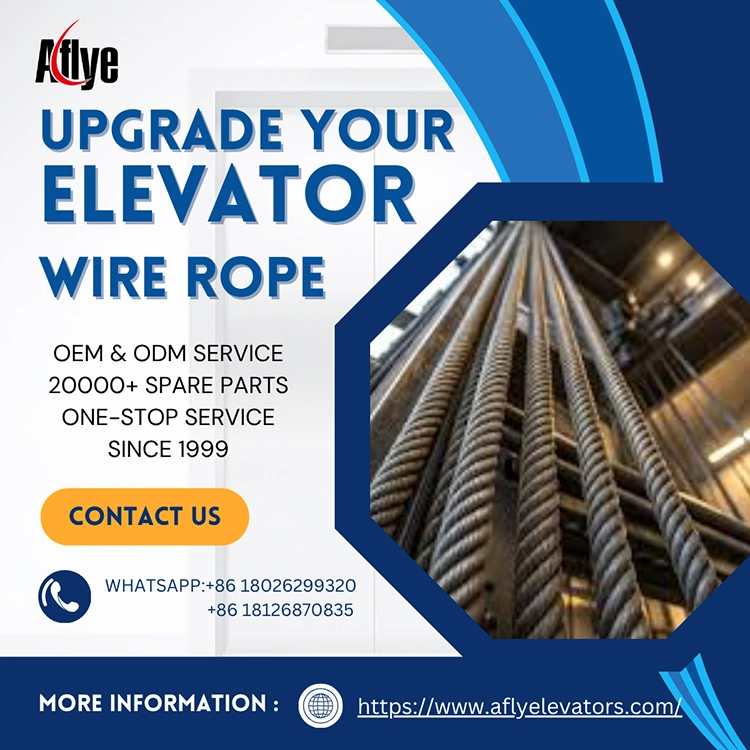How Long Does an Elevator Wire Rope Typically Last Before It Needs to Be Replaced?
In the elevator traction system, the elevator wire rope is one of the core components that bears the weight of the car, the counterweight, and the load. Whether the elevator can operate smoothly, steadily, and safely depends largely on the condition of the wire ropes. However, many property managers or users do not have a clear understanding of the wire rope’s service life, and some even mistakenly believe that “the wire rope is thick and not easy to break,” which leads to delayed replacement. So, how long can elevator wire ropes actually be used? When must they be replaced?
Today, A-FLY Elevator & Escalator Parts Supplier provides you with an authoritative and easy-to-understand explanation.

1. How long do elevator wire ropes generally last before replacing?
Typically, the designed service life of elevator wire ropes is 5–10 years.
However, the actual lifespan is affected by several factors:
- Elevator usage frequency
- Building traffic volume
- Whether maintenance is performed properly
- Wear condition of the traction sheave grooves
- Environmental factors such as humidity, temperature, and oil contamination
In high-traffic places such as shopping malls, subway stations, and hotels, wire ropes may need to be replaced every 3–5 years.
In low-usage residential buildings, wire rope life can extend to 8–10 years.
General principle: Lifespan depends on wear, not time alone.
2. What signs indicate that wire ropes must be replaced?
If any of the following conditions appear, you must immediately evaluate or directly replace the wire ropes:
1. Significant increase in broken wires
Once any strand shows broken wires that continue to increase, it is the clearest sign for replacement. Excessive broken wires reduce the rope’s load-bearing capacity and may even lead to rope breakage.
2. Twisting, deformation, or flattening of the wire rope
Uneven force or excessive wear of the sheave grooves may cause deformation, reducing strength and causing noticeable vibration.
3. Rust or severe corrosion
Corrosion weakens the metal structure of the wire rope and reduces its load capacity. Damp shafts or lack of cleaning usually lead to this issue.
4. Reduced rope diameter
Over long-term operation, the diameter of the wire rope gradually decreases. When the reduction exceeds standard limits, replacement is required.
5. Increased running noise or friction
This indicates poor matching with the sheave groove or damage to the rope body.
6. Uneven tension among multiple ropes (rope jump phenomenon)
Uneven tension causes elevator vibration, accelerated wear, and serious safety hazards.
3. Why must wire ropes be replaced regularly?
Wire ropes are the first critical safety barrier in elevator operation.
Delaying replacement may cause:
- Elevator vibration and inaccurate leveling
- Unstable operation and poor ride comfort
- Increased risk of rope breakage
- Additional wear on traction sheave grooves
- Severe cases may even cause elevator falling accidents
Among all elevator components, wire rope maintenance and replacement should never be ignored.
4. How to extend the service life of wire ropes?
A-FLY recommends:
- Regularly check rope lubrication
- Maintain balance between the car and counterweight
- Avoid overloading
- Keep traction sheave grooves in good condition
- Regularly check rope tension
5. What wire rope solutions does A-FLY provide?
As a professional elevator & escalator parts supplier, A-FLY offers multiple specifications and structures of special elevator wire ropes, including:
- 6×19, 6×25, 8×19 elevator ropes
- Common diameters: 8mm, 10mm, 12mm, 13mm, 16mm
- Suitable for passenger elevators, freight elevators, hospital lifts, and high-rise elevators
- High-tensile, high-flexibility, wear-resistant wire ropes
- Complete traction accessories including rope heads, rope clips, and rope sockets
Features of A-FLY wire ropes:
- International standard materials
- High tensile strength and high safety factor
- Soft rope body, smooth operation
- Longer service life
- Compatible with multiple elevator brands
Whether for maintenance replacement, modernization, or new installations, A-FLY provides reliable wire rope solutions.
6. Conclusion: The health of the wire rope is the foundation of elevator safety
Elevator wire ropes are not “safer because they are thick”—they are safer when they are in good condition. Once significant wear, deformation, broken wires, or noise appear, an inspection or replacement should be done immediately.
Choose A-FLY, so every wire rope becomes a stable force ensuring safe elevator operation—keeping your elevator running smoothly, reliably, and safely for the long term.

